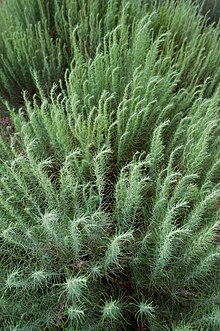Artemisia filifolia
| Artemisia filifolia | |
|---|---|
 |
|
| Scientific classification | |
| Kingdom: | Plantae |
| (unranked): | Angiosperms |
| (unranked): | Eudicots |
| (unranked): | Asterids |
| Order: | Asterales |
| Family: | Asteraceae |
| Genus: | Artemisia |
| Species: | A. filifolia |
| Binomial name | |
|
Artemisia filifolia Torr. |
|
| Synonyms | |
|
|
Artemisia filifolia, known by common names including sand sagebrush, sand sage and sandhill sage, is a species of flowering plant in the aster family. It is native to North America, where it occurs from Nevada east to South Dakota and from there south to Arizona, Chihuahua, and Texas.
Artemisia filifolia is a branching woody shrub growing up to 1.5 metres (4 ft 11 in) tall. The stems are covered narrow, threadlike leaves up to 8 centimetres (3.1 in) long and no more than half a millimeter wide. The leaves are sometimes split into segments. They are solitary or arranged in fascicles. The inflorescence is a panicle of hanging flower heads. Each head contains sterile disc florets and 2 to 3 fertile ray florets. The fruit is a tiny achene. The achenes do not tend to disperse far from the parent plant.
Artemisia filifolia is a dominant species across much of the west-central United States, particularly in areas where the substrate is a deep, sandy soil. It is an indicator of sandy soils. It is efficient for preventing erosion on such soils. It is common in parts of the Great Plains, where it is a dominant component of prairie, grassland, and shrubland ecosystems alongside grasses such as sand bluestem, grama grasses, sand reedgrass, little bluestem, and sand dropseed. Some regions dominated by this sagebrush include the occurrences of the sandsage prairie from Nebraska to central Texas, various river systems in eastern Colorado and Kansas, the sandhills and mixed-grass prairies of Colorado, and parts of southeastern Wyoming. In Texas, it is common in the Trans-Pecos region, where it grows with honey mesquite, and many other areas in the state where it grows with sand shinnery oak.
...
Wikipedia

